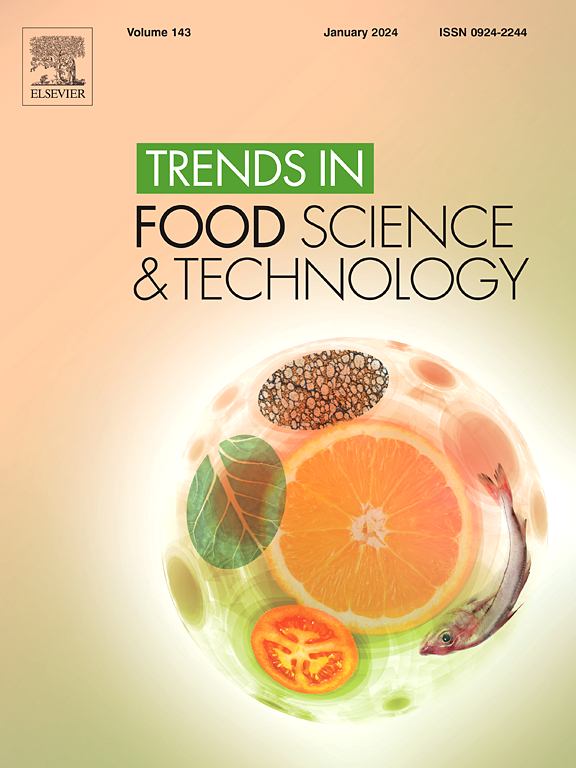The potential of ethyl lauroyl arginate (LAE)-based active packaging: current status, technical challenges, and research gaps
IF 15.1
1区 农林科学
Q1 FOOD SCIENCE & TECHNOLOGY
引用次数: 0
Abstract
Background
Ethyl lauroyl arginate (LAE) is a cationic antimicrobial compound generally recognized as safe and globally approved as a food additive. Compared to most food-grade antimicrobials, LAE demonstrates superior efficacy without compromising food flavor or quality and improving food safety. Due to its effectiveness, LAE has been extensively studied for food applications, both as an additive and as an active compound in antimicrobial packaging to delay spoilage and enhance shelf life.
Scope and approach
While existing reviews have covered LAE's physicochemical properties, mechanisms of action, and use as a food additive and in edible films and coatings, a comprehensive overview of its incorporation into active packaging systems remains lacking.
This review addresses the incorporation of LAE into conventional and biobased polymers, focusing on the antimicrobial performance of these systems when applied to food. Additionally, it analyzes LAE release mechanisms into various matrices.
Key findings and conclusions
Current research is primarily limited to water-soluble biopolymers and solvent-casting methods at the laboratory scale. To address these limitations, future research should focus on non-water-soluble polymers and industrial scale processes, such as thermal processing and coatings, to develop effective, commercially viable LAE-based packaging. Furthermore, hydrophobic polymers exhibit more sustained LAE release than hydrophilic materials. Although no commercial LAE-containing active packaging currently exists, this gap highlights the need for further research toward real-world application.
This review provides an overview of recent advances, offering valuable insights for researchers and industry professionals aiming to develop LAE-based active packaging systems that enhance food preservation and reduce waste.

月桂酰精氨酸乙酯(LAE)基活性包装的潜力:现状、技术挑战和研究空白
月桂酰精氨酸乙酯(LAE)是一种公认安全的阳离子抗菌化合物,是全球公认的食品添加剂。与大多数食品级抗菌剂相比,LAE在不影响食品风味或质量和提高食品安全的情况下表现出卓越的功效。由于其有效性,LAE在食品应用方面得到了广泛的研究,既可以作为添加剂,也可以作为抗菌包装中的活性化合物,以延缓腐败和延长保质期。范围和方法虽然现有的评论已经涵盖了LAE的物理化学性质,作用机制,以及作为食品添加剂和可食用薄膜和涂层的用途,但其在活性包装系统中的综合概述仍然缺乏。本文综述了LAE与传统聚合物和生物基聚合物的结合,重点介绍了这些系统在食品中的抗菌性能。此外,分析了LAE在各种矩阵中的释放机制。目前的研究主要局限于水溶性生物聚合物和实验室规模的溶剂铸造方法。为了解决这些限制,未来的研究应该集中在非水溶性聚合物和工业规模的工艺上,如热处理和涂层,以开发有效的、商业上可行的lae基包装。此外,疏水聚合物比亲水材料表现出更持久的LAE释放。虽然目前还没有含有lae的商业活性包装存在,但这一差距突出了对现实世界应用的进一步研究的必要性。这篇综述综述了最近的进展,为研究人员和行业专业人士提供了有价值的见解,旨在开发基于lae的活性包装系统,增强食品保存和减少浪费。
本文章由计算机程序翻译,如有差异,请以英文原文为准。
求助全文
约1分钟内获得全文
求助全文
来源期刊

Trends in Food Science & Technology
工程技术-食品科技
CiteScore
32.50
自引率
2.60%
发文量
322
审稿时长
37 days
期刊介绍:
Trends in Food Science & Technology is a prestigious international journal that specializes in peer-reviewed articles covering the latest advancements in technology, food science, and human nutrition. It serves as a bridge between specialized primary journals and general trade magazines, providing readable and scientifically rigorous reviews and commentaries on current research developments and their potential applications in the food industry.
Unlike traditional journals, Trends in Food Science & Technology does not publish original research papers. Instead, it focuses on critical and comprehensive reviews to offer valuable insights for professionals in the field. By bringing together cutting-edge research and industry applications, this journal plays a vital role in disseminating knowledge and facilitating advancements in the food science and technology sector.
 求助内容:
求助内容: 应助结果提醒方式:
应助结果提醒方式:


